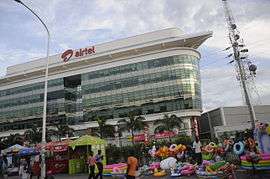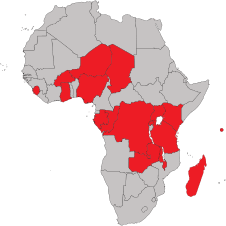Airtel Tanzania
 | |
| Public | |
| Industry | Telecommunications |
| Predecessors |
Zain Tanzania Celtel Tanzania |
| Founded | 08 June 2010 |
| Headquarters | Dar Es Salaam, Tanzania |
Area served | Tanzania |
| Products |
GSM-related products Internet services |
| Parent | Airtel Africa |
| Website | africa.airtel.com/Tanzania |

Airtel Tanzania Limited is the largest telecommunications company in Tanzania by coverage area and the second-largest telecommunications company in Tanzania after Vodacom Tanzania based on total wireless customers, with about 1.7 million users (26 percent market share) by August 2007.
The company is the part of Airtel Africa, the pan African mobile network operator and the largest mobile service provider in Africa outside of South Africa. Airtel Tanzania is the pioneer and part of the "One Network", the world's first borderless network across East Africa.[1]
Airtel Tanzania was the first telecom company to launch General Packet Radio Service/Enhanced Data Rates for GSM Evolution (GPRS/EDGE)[2] service in Tanzanian Market on April 3, 2006. Celtel Tanzania has its headquarters in Celtel House, Dar Es Salaam. On August 1, 2008, Celtel rebranded all of its African operations under the Zain name.[3]
History
Airtel Tanzania was the result of partial privatization of TTCL on February 23, 2001. This was one of the first steps towards full liberalization of the market. In the aftermath, Celtel International, at that time MSI, which has its headquarters in Amsterdam, Netherlands, together with Detecon from Germany, obtained 35% shares from the Government of Tanzania.[4] Thus, the consortium (Celtel International and Detecon ) took over Board and Management control of TTCL and thus made it essentially an autonomous company. Celtel is currently owned by sub group originating from UAE.
Licensed
Celtel Tanzania was licensed as the mobile operator in the country in November 2001. The license was the result of Tanzania Communications Commission ( TCC ) to decide and to change its zonal licenses into national licenses in 1998. The changes was because the numbers of subscribers in the country was very low (i.e. a total of 37,940 in 1998) and operators were concentrating on a few zones only (i.e. the coastal area near Dar es Salaam and Zanzibar).
Celtel Tanzania Partnership
During the privatisation of Tanzania Telecommunications Company Limited ( TTCL ) Celtel International was in partnership with Detecon of Germany. The two companies invested an initial $60 million in TTCL in February 2001 for a 35% shareholding in TTCL. In the new partnership with TTCL, Celtel International agreed to be bound by independent "Expert Determination" in the aftermath of a poor financial performance of TTCL for the year 2000. Based on this "Expert Determination", Celtel International made an additional $4.96 million payment.
In early August 2005, Celtel Tanzania and TTCL were legally separated, allowing each to administer its own financial and business operations. In this new formally signed agreement between the Tanzanian Government and Celtel Tanzania, TTCL's shareholding structure remained unchanged, with the government of Tanzania holding 65% and Celtel International the remaining 35%. In the aftermath, Celtel Tanzania's structure was changed so as to follow the government’s decision to sell a 25% stake in the cellco to Celtel International for USD28 million.[5]
Acquisition by Zain
On September 2007 Celtel's Parent Company MTC Group was acquired by Zain (Arabic for ‘beautiful, good and wonderful) unifying its different brands in 22 Countries.[6] This led to the rebranding of Celtel Tanzania to Zain Tanzania.
Acquisition by Bharti Airtel
On June 8, 2010, Bharti Airtel struck a deal to purchase of mobile operations in 15 African countries from Zain, a Kuwaiti operator including Zain Tanzania.[7] The company however did not acquire Zain sudan. The firm the changed its name to Airtel Tanzania.
One Network

As of January 2016 Airtel Africa operates in 17 African countries. Marketed as "One Network" airtel was the first telecom company in Africa to provide a border less solution for its customer across the continent. With this service airtel customer can freely roam in other airtel operating countries and use their phone as a local subscriber.[8] This service has been extended to India, Bangladesh and Sri Lanka where airtel Africa users would not have to change their sim cards to operate freely in the three Asian nations.[9]
Recharging while roaming on the "One Network" can be done both in local currency or can be done remotely from one's home country. The airtel money services do not work across borders, however there are plans to implement airtel money between Kenya and Tanzania.[10]
See also
- MIC Tanzania Limited (tiGO)
- Vodacom Tanzania
- Celtel International
- Celtel Africa Challenge
- Vodacom
- 3G Technology
External links
References
- ↑ Celtel goes borderless, seamless in East Africa
- ↑ Celtel introduces first GPRS/EDGE service in Tanzania
- ↑ Global aspirations: leading emerging markets mobile operator Zain rebrands Celtel Africa operations.
- ↑ Market Liberalization Strategy: 2001-Present
- ↑ Celtel and TTCL part company
- ↑ "Zain - about-us - milestones". Zain Group. Retrieved 2015-08-06.
- ↑ Tripathy, Devidutta; Goma, Eman (8 June 2010). "Bharti closes $9 billion Zain Africa deal". Reuters. Reuters. Retrieved 7 September 2014.
- ↑ "Airtel Customers in Africa to Now Get Free Incoming Calls While Roaming on its South Asia Network". Database of Press Releases related to Africa - APO-Source. Retrieved 2016-01-06.
- ↑ "AIRTEL Customers in AFRICA to Get FREE Incoming Calls While International Roaming in India, Sri Lanka and Bangladesh". Telecom Talk. Retrieved 2016-01-06.
- ↑ "Airtel Ghana". africa.airtel.com. Retrieved 2016-01-06.